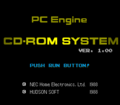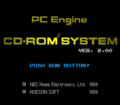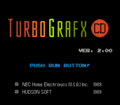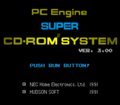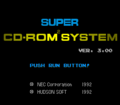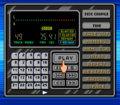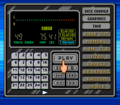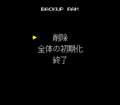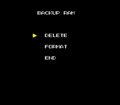Difference between revisions of "CD-ROM² systems/Boot ROM"
From NEC Retro
m (Text replacement - "|prototype=no}}" to "}}") |
|||
| (3 intermediate revisions by the same user not shown) | |||
| Line 1: | Line 1: | ||
{{back}} | {{back}} | ||
{{ScreenThumb|BootROM CDROM2 JP 1.00.png|The original Japanese CD-ROM² boot ROM, version 1.00. Note the lack of a superscript <sup>2</sup> next to "CD-ROM" in the title, which was added in subsequent revisions.}} | {{ScreenThumb|BootROM CDROM2 JP 1.00.png|The original Japanese CD-ROM² boot ROM, version 1.00. Note the lack of a superscript <sup>2</sup> next to "CD-ROM" in the title, which was added in subsequent revisions.}} | ||
| − | One of the most important components in a [[CD-ROM² systems|CD-ROM² system]] is a '''boot ROM''' - an interface which appears when the console is given power. While a [[PC Engine]] [[HuCard]] can boot almost instantaneously, CD-ROMs require verification and loading, which depending on the quality of the disc or drive, can take several seconds. In addition to help drive the CD-ROM, the CD-ROM² boot ROM informs the user that console is in CD-ROM² mode, and | + | One of the most important components in a [[CD-ROM² systems|CD-ROM² system]] is a '''boot ROM''' - an interface which appears when the console is given power. While a [[PC Engine]] [[HuCard]] can boot almost instantaneously, CD-ROMs require verification and loading, which depending on the quality of the disc or drive, can take several seconds. In addition to help drive the CD-ROM, the CD-ROM² boot ROM informs the user that the console is in CD-ROM² mode, and crucially gives them something more interesting to look at than a blank screen. |
The boot ROM was originally not something built-in to the original [[CD-ROM²]] unit nor the [[Interface Unit]], but was rather distributed in the form of special HuCards known as [[System Card]]s to be inserted into the PC Engine or [[TurboGrafx-16]], allowing these systems to interface with the CD-ROM² unit. All later units, such as the [[Super CD-ROM²]] unit as well as the [[PC Engine Duo]] and its variants, come with the boot ROM pre-installed. | The boot ROM was originally not something built-in to the original [[CD-ROM²]] unit nor the [[Interface Unit]], but was rather distributed in the form of special HuCards known as [[System Card]]s to be inserted into the PC Engine or [[TurboGrafx-16]], allowing these systems to interface with the CD-ROM² unit. All later units, such as the [[Super CD-ROM²]] unit as well as the [[PC Engine Duo]] and its variants, come with the boot ROM pre-installed. | ||
==Functions== | ==Functions== | ||
| − | Compared to later CD-based systems from other manufacturers, CD-ROM² boot ROMs feature a basic interface and offer the same functionality - principly to run CD-ROM² games. Most models can also play music CDs, with support for CD+G discs added in version 2.00 onwards. Upon boot, the user is instructed to press {{Run}} to boot the inserted disc, displaying "LOAD ERROR!" if the disc could not be recognised. | + | Compared to later CD-based systems from other manufacturers, CD-ROM² boot ROMs feature a basic interface and offer the same functionality - principly to run CD-ROM² games. Most models can also play music CDs, with support for CD+G discs added in version 2.00 onwards. Upon boot, the user is instructed to press {{Run}} to boot the inserted disc, displaying "LOAD ERROR!" if the disc could not be recognised. In addition, the user can manage data saved within the CD-ROM² unit's 2kB backup RAM by pressing {{Select}} on the main screen to display a menu. In this menu, the user can choose to delete specific files they no longer need to make room for new files, or format the backup RAM entirely. |
| − | + | Version 2.10, available exclusively in Japan on stand-alone System Cards, added the ability to auto-detect disc changes. Version 3.00, designed for the Super CD-ROM² format, has "SUPER" appended to the main screen and was distributed on [[Super System Card]]s, as well as on the [[Arcade Card Pro]] and [[Arcade Card Duo]]. The first North American boot ROM changed the logo displayed on the main screen entirely to a "[[TurboGrafx-CD]]" logo, while version 3.00, pre-installed in the [[TurboDuo]], copies the logo from the Japanese 3.00 but removes the "PC Engine" part and slightly moves the position of the logo upwards. | |
| − | + | Some games may perform graphical effects with the main screen at startup. For example, ''[[Flash Hiders]]'' will fade out everything except for the "S" and "R" in "SUPER", then rearrange the letters to form the initials for publisher [[Right Stuff]]. These graphical effects are often intended for the region the games were originally released in, and may result in inconsistencies when played using a different region boot ROM. | |
==Screenshots== | ==Screenshots== | ||
| Line 22: | Line 22: | ||
BootROM SCDROM2 US 3.00.png|US 3.00 | BootROM SCDROM2 US 3.00.png|US 3.00 | ||
</gallery> | </gallery> | ||
| − | ===CD | + | ===Audio CD playback=== |
<gallery> | <gallery> | ||
BootROM CDROM2 1.00 CDPlayback.png|JP 1.00 | BootROM CDROM2 1.00 CDPlayback.png|JP 1.00 | ||
BootROM CDROM2 2.00 CDPlayback.png|JP/US 2.00-3.00 | BootROM CDROM2 2.00 CDPlayback.png|JP/US 2.00-3.00 | ||
</gallery> | </gallery> | ||
| + | |||
===Backup RAM menu=== | ===Backup RAM menu=== | ||
<gallery> | <gallery> | ||
| Line 63: | Line 64: | ||
===ROM dump status=== | ===ROM dump status=== | ||
{{romtable| | {{romtable| | ||
| − | {{rom|PCE|sha1=a39a66da7de6ba94ab84d04eef7afeec7d4ee66a|md5=2b7ccb3d86baa18f6402c176f3065082|crc32=3f9f95a4|size=256kB|date=1988-09{{intref|CD-ROM² systems/Boot ROM/Hidden content#Developer message and credits}}|source=Card (JP)|comments=v1.00|quality= | + | {{rom|PCE|sha1=a39a66da7de6ba94ab84d04eef7afeec7d4ee66a|md5=2b7ccb3d86baa18f6402c176f3065082|crc32=3f9f95a4|size=256kB|date=1988-09{{intref|CD-ROM² systems/Boot ROM/Hidden content#Developer message and credits}}|source=Card (JP)|comments=v1.00|quality=}} |
| − | {{rom|PCE|sha1=f92ea593c8a935f58f8e1c3b2fc730951ec4fa71|md5=3a456f0eccff039eb5ff045f56ec1c3b|crc32=52520bc6|size=256kB|date= |source=Card (JP)|comments=v2.00|quality= | + | {{rom|PCE|sha1=f92ea593c8a935f58f8e1c3b2fc730951ec4fa71|md5=3a456f0eccff039eb5ff045f56ec1c3b|crc32=52520bc6|size=256kB|date= |source=Card (JP)|comments=v2.00|quality=}} |
| − | {{rom|PCE|sha1=88da02e2503f7c32810f5d93a34849d470742b6d|md5=3cdd6614a918616bfc41c862e889dd79|crc32=283b74e0|size=256kB|date= |source=Card (JP)|comments=v2.10|quality= | + | {{rom|PCE|sha1=88da02e2503f7c32810f5d93a34849d470742b6d|md5=3cdd6614a918616bfc41c862e889dd79|crc32=283b74e0|size=256kB|date= |source=Card (JP)|comments=v2.10|quality=}} |
| − | {{rom|PCE|sha1=79f5ff55dd10187c7fd7b8daab0b3ffbd1f56a2c|md5=38179df8f4ac870017db21ebcbf53114|crc32=6d9a73ef|size=256kB|date= |source=Card (JP)|comments=v3.00|quality= | + | {{rom|PCE|sha1=79f5ff55dd10187c7fd7b8daab0b3ffbd1f56a2c|md5=38179df8f4ac870017db21ebcbf53114|crc32=6d9a73ef|size=256kB|date= |source=Card (JP)|comments=v3.00|quality=}} |
| − | {{rom|TG16|sha1=2bea3dac98f84b2f2f469fa77ea720b8770d598d|md5=94279f315e8b52904f65ab3108542afe|crc32=ff2a5ec3|size=256kB|date= |source=Card (US)|comments=v2.00|quality= | + | {{rom|TG16|sha1=2bea3dac98f84b2f2f469fa77ea720b8770d598d|md5=94279f315e8b52904f65ab3108542afe|crc32=ff2a5ec3|size=256kB|date= |source=Card (US)|comments=v2.00|quality=}} |
| − | {{rom|TG16|sha1=d02611d99921986147c753df14c7349b31d71950|md5=0754f903b52e3b3342202bdafb13efa5|crc32=2b5b75fe|size=256kB|date= |source=Card (US)|comments=v3.00|quality= | + | {{rom|TG16|sha1=d02611d99921986147c753df14c7349b31d71950|md5=0754f903b52e3b3342202bdafb13efa5|crc32=2b5b75fe|size=256kB|date= |source=Card (US)|comments=v3.00|quality=}} |
}} | }} | ||
Latest revision as of 03:19, 5 May 2023
- Back to: CD-ROM² systems.
One of the most important components in a CD-ROM² system is a boot ROM - an interface which appears when the console is given power. While a PC Engine HuCard can boot almost instantaneously, CD-ROMs require verification and loading, which depending on the quality of the disc or drive, can take several seconds. In addition to help drive the CD-ROM, the CD-ROM² boot ROM informs the user that the console is in CD-ROM² mode, and crucially gives them something more interesting to look at than a blank screen.
The boot ROM was originally not something built-in to the original CD-ROM² unit nor the Interface Unit, but was rather distributed in the form of special HuCards known as System Cards to be inserted into the PC Engine or TurboGrafx-16, allowing these systems to interface with the CD-ROM² unit. All later units, such as the Super CD-ROM² unit as well as the PC Engine Duo and its variants, come with the boot ROM pre-installed.
Contents
Functions
Compared to later CD-based systems from other manufacturers, CD-ROM² boot ROMs feature a basic interface and offer the same functionality - principly to run CD-ROM² games. Most models can also play music CDs, with support for CD+G discs added in version 2.00 onwards. Upon boot, the user is instructed to press RUN to boot the inserted disc, displaying "LOAD ERROR!" if the disc could not be recognised. In addition, the user can manage data saved within the CD-ROM² unit's 2kB backup RAM by pressing SELECT on the main screen to display a menu. In this menu, the user can choose to delete specific files they no longer need to make room for new files, or format the backup RAM entirely.
Version 2.10, available exclusively in Japan on stand-alone System Cards, added the ability to auto-detect disc changes. Version 3.00, designed for the Super CD-ROM² format, has "SUPER" appended to the main screen and was distributed on Super System Cards, as well as on the Arcade Card Pro and Arcade Card Duo. The first North American boot ROM changed the logo displayed on the main screen entirely to a "TurboGrafx-CD" logo, while version 3.00, pre-installed in the TurboDuo, copies the logo from the Japanese 3.00 but removes the "PC Engine" part and slightly moves the position of the logo upwards.
Some games may perform graphical effects with the main screen at startup. For example, Flash Hiders will fade out everything except for the "S" and "R" in "SUPER", then rearrange the letters to form the initials for publisher Right Stuff. These graphical effects are often intended for the region the games were originally released in, and may result in inconsistencies when played using a different region boot ROM.
Screenshots
Main screen
Audio CD playback
Hidden content
- Main article: CD-ROM² systems/Boot ROM/Hidden content.
Production credits
- PRODUCER: 中本伸一
- DIRECTOR: 野沢勝広
- CD-ROM SIMULATOR: 本迫芳夫
- BIOS MAIN CODE, CD-PLAYER: 小林敬樹
- BIOS CHECK MONITOR, SRAM MANAGER: 飛田雅宏
- BACKUP MEMORY MAINTENANCE: 金田孝司
- CD-PLAYER SUB: 三上 哲
- PSG DRIVER: 岩淵貴幸
- GRAPHIC DRIVER: 岩崎啓真
- GRAPHIC DRIVER SUB: 及川克之
- 8x8 ANK FONT: 松浦浩司
- CD-PLAYER DESIGN: 伊藤真樹
- TITLE DESIGN: 武田真理
- 12x12 KANJI FONT: 角谷 篤, 山口もと, 岡田寿夫
- NEC Home Electoronics: 鈴木孝治, 牧野 孝, 益子泰尚, 野坂和彦, 新井宏昭
- 1988 Sep. Written by TAKAKI KOBAYASHI
Technical information
ROM dump status
| System | Hash | Size | Build Date | Source | Comments | |||||||||
|---|---|---|---|---|---|---|---|---|---|---|---|---|---|---|
| ? |
|
256kB | 1988-09[1] | Card (JP) | v1.00 | |||||||||
| ? |
|
256kB | Card (JP) | v2.00 | ||||||||||
| ? |
|
256kB | Card (JP) | v2.10 | ||||||||||
| ? |
|
256kB | Card (JP) | v3.00 | ||||||||||
| ? |
|
256kB | Card (US) | v2.00 | ||||||||||
| ? |
|
256kB | Card (US) | v3.00 |
References
| CD-ROM² systems |
|---|
| CD-ROM² (1988) | Super CD-ROM² (1991) | Arcade CD-ROM² (1994) |
| Hardware |
| CD-ROM² (Interface Unit | RAU-30) (1988) | TurboGrafx-CD (1989) | PC Engine Duo (1991) | Super CD-ROM² (Super CD-ROM² Adaptor) (1991) | TurboDuo (1992) | PC Engine Duo-R (1993) | LaserActive (1993) |
| System Cards |
| System Card | Super System Card | Arcade Card Pro/Duo |
| Games Express CD Card |

